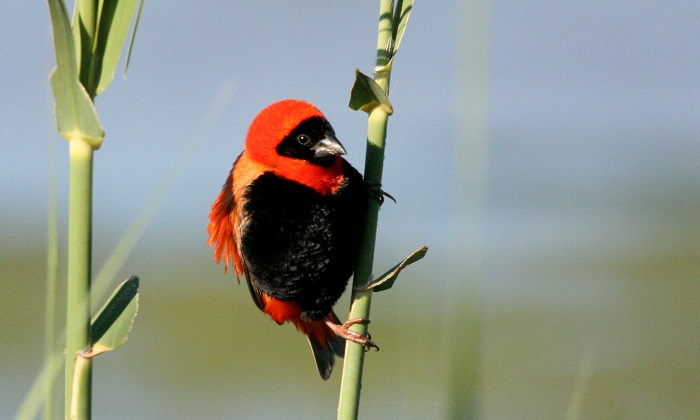Cover image by Lia Steen – Lake Chrissie, Mpumalanga – BirdPix No. 236
Identification
The Southern Red Bishop is one of the most distinctively plumaged birds in the region. In its scarlet and black breeding plumage, this is probably one of the most familiar southern African birds.
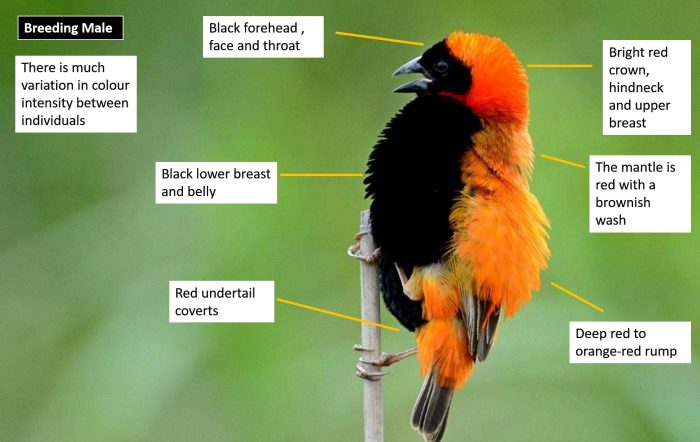
Umgeni Valley Nature Reserve, KwaZulu-Natal
Photo by Dave Rimmer
The Southern Red Bishop is sexually dimorphic with females looking quite different to the breeding males.
Breeding males are entirely black and bright red. Their foreheads, face and throat are black. The black face mask is encircled by red on the crown, hind neck and upper breast. The extent of black on the forecrown and throat varies individually. The mantle is red with a slight brownish wash, while the rump and upper tail coverts are deep red to orange-red. There is a considerable amount of variation in colour intensity between individuals. The lower breast and belly is black and the under tail coverts are red. The eyes, legs and feet are brown and the bill is black.
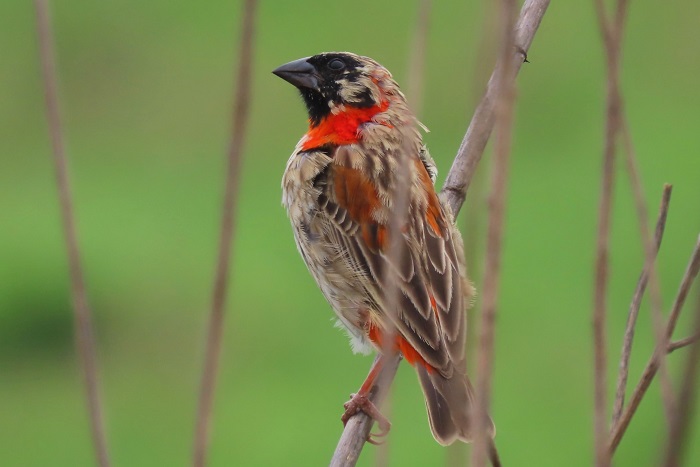
Thurlow Nature Reserve, KwaZulu-Natal
Photo by Malcolm Robinson
Non-breeding males have a pale buffy supercilium that contrasts with the brown lores, cheeks and ear coverts. The upper parts are buffy brown and the feathers have dark brown central streaks. The throat is whitish and the breast and flanks are buff coloured with dark brown streaking. The rest of the underparts are creamy-white. The bill, legs and feet are brown.
Adult females resemble the non-breeding males but show less heavy streaking on the breast and flanks.
Juveniles resemble females but have broad buffy margins to the feathers on the upper parts. The underparts are buff-coloured.

Lufafa Valley, KwaZulu-Natal
Photo by Malcolm Robinson
The Southern Red Bishop is unlike any other bird in southern Africa, except for the Black-winged Bishop (Euplectes hordeaceus) which, in southern Africa, occurs only in north-eastern Zimbabwe and adjoining Mozambique. Breeding males of the latter are larger, with black (not brown) wings and tails and a mainly red (not black) forehead.
Females and non-breeding birds are frequently overlooked or misidentified. This problem is compounded by the communal flocking and roosting behaviour of this species with other similar seed-eating birds.
Status and Distribution
The Southern Red Bishop is Locally common to abundant, especially in the Western Cape and the grasslands of the eastern plateau of South Africa and Zimbabwe.
The Southern Red Bishop is distributed from south-western Kenya and southern Uganda across to Angola and throughout southern Africa. Within southern Africa it is localised in Namibia, and north-western and south-eastern Botswana. It is strangely uncommon in the Okavango Delta and is mostly absent from large parts of the Kalahari. The Southern Red Bishop is more wide-ranging in Zimbabwe, South Africa, eSwatini and Lesotho. This species is also quite localised in Mozambique, occurring mainly along river systems.
Crop farming and the construction of dams have allowed the Southern Red Bishop to greatly increase its distribution and abundance. Conversely, the draining of wetlands and the loss of reedbeds have caused some local reductions in numbers.
The crop-raiding habits of the Southern Red Bishop can bring it into conflict with farmers. It is an unprotected pest species in the Western Cape and in cereal and grain growing areas. Despite this, the Southern Red Bishop remains common and is not under threat.
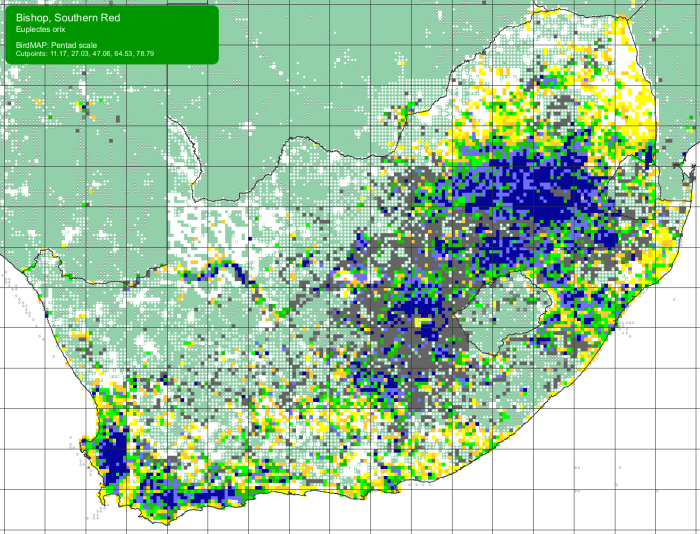
Details for map interpretation can be found here.
Habitat
Southern Red Bishops breed in reedbeds in marshes and around rivers and dams, even small isolated patches of reeds or bulrushes. Away from breeding areas they are primarily a grassland species. However, the Southern Red Bishop inhabits a range of other vegetation types too, from savanna to the Karoo, fynbos and forest edge, provided there is enough grassy habitat in which to forage and access to reedbeds for breeding.
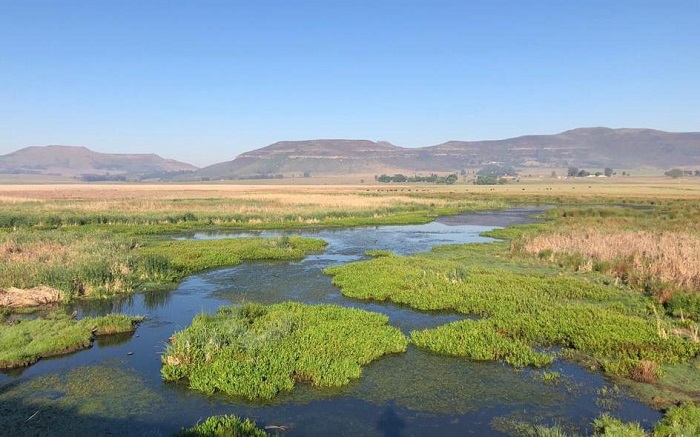
Wakkerstroom, Mpumalanga
Photo by Rowan Poortier
The Southern Red Bishop is closely associated with agriculture in many areas, especially where crops are well irrigated. It is often abundant in these areas.
Occasionally forages along the coast in the intertidal zone where they feed on kelp flies and small crustaceans among the washed up seaweed and other debris.
Behaviour
The Southern Red Bishop is gregarious throughout the year, forming large flocks in the non-breeding season, often with other seed-eating species like sparrows, canaries, weavers, queleas and other Euplectes species. Regularly bathes and drinks water, especially in arid areas. Southern Red Bishops typically roosts in reedbeds, often with other related species.
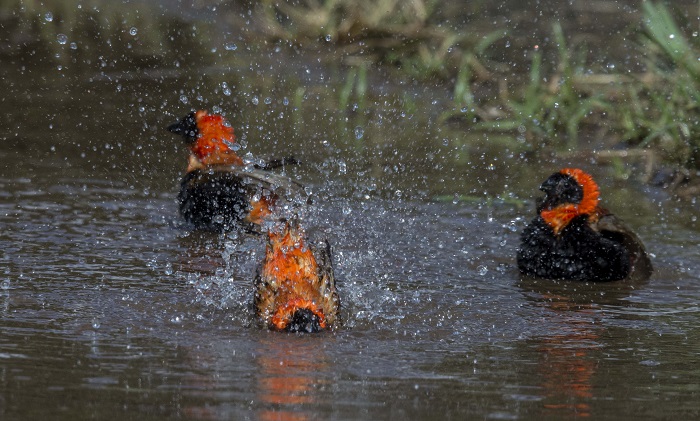
Klerksdorp, North West
Photo by Tony Archer
Feeds in flocks, both on the ground and perched in vegetation. They mainly consume grass and crop seeds, and other plant material. Invertebrates make up a relatively small part of the diet. Invertebrate food includes beetles and their larvae, caterpillars, dragonflies termites and spiders. Termite alates are caught on the ground or hawked aerially. They are also known to take small amounts of nectar.
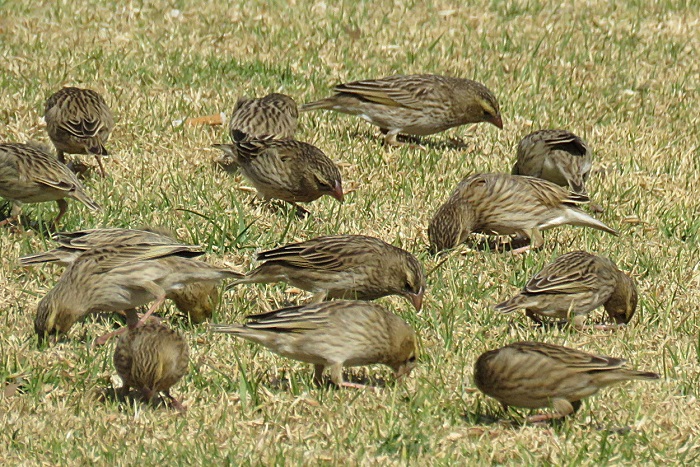
Near Belfast, Mpumalanga
Photo by Derek Kennedy
Southern Red Bishops are colonial nesters, usually in reeds (Phragmites spp) and Bulrushes (Typha capensis). They are highly territorial, establishing small territories averaging 8 square meters in size. Males defend their territories against conspecifics and against the males of other Bishop, Widow and Weaver species. Males spend much time giving threat displays along their territory boundaries, by fanning their tails, stretching their necks and raising the red feathers surrounding the black face mask. Males may occasionally fight, sometimes falling together into the water below their nests. Once their territory boundaries become established the aggressive behaviour decreases.
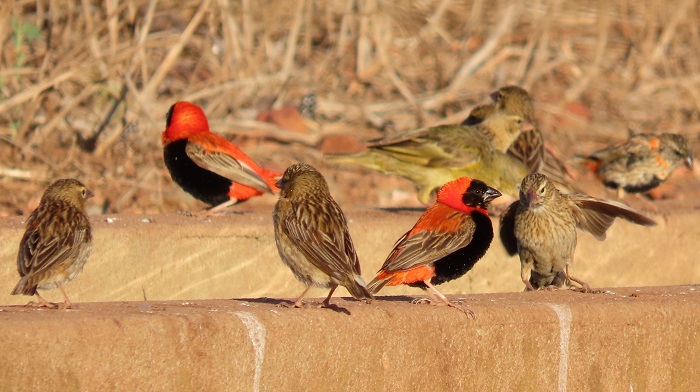
Near Malgas, Western Cape
Photo by Johan and Estelle van Rooyen
When a female enters a territory, the courting male approaches in Bumble-flight with all body feathers raised, but especially the crown, rump and belly. He then perches and continues to display with his feathers raised. Copulation occurs after the female approves the nest he has built.
Southern Red Bishops are polygynous (males mate with multiple females during the breeding season), and successful males often attract 3 to 8 females.
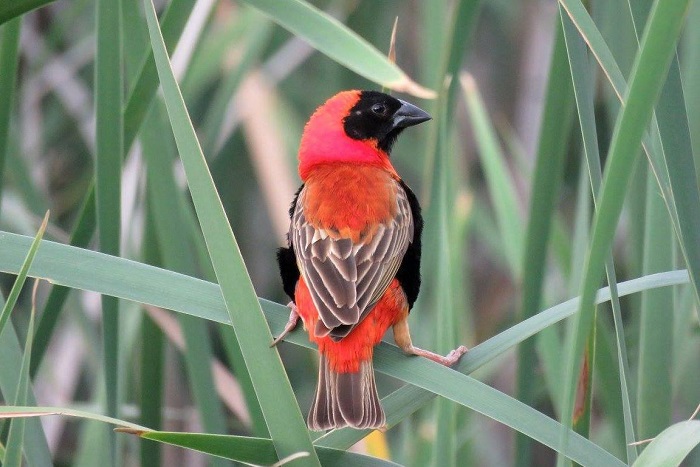
Morelata Kloof Nature Reserve, Gauteng
Photo by Pieter Cronje
Nests are constructed entirely by the males and they can produce up to 13 nests per season. It usually takes the males 2 to 3 days to build a nest but they can sometimes complete one within 24 hours. The nest is a tightly woven, upright oval, made from strips of reed leaves or grass blades. The nest is made with a side-top entrance under a porch. Nest entrances are often orientated away from the direction of the prevailing rain. The female adds the nest lining, composed of plant down and grass seed-heads.
In the winter rainfall region of South Africa, the breeding season is largely from August to December. Breeding starts later in the summer rainfall regions, mainly from October to March. Breeding is later still in Namibia and Zimbabwe and runs from December to April.
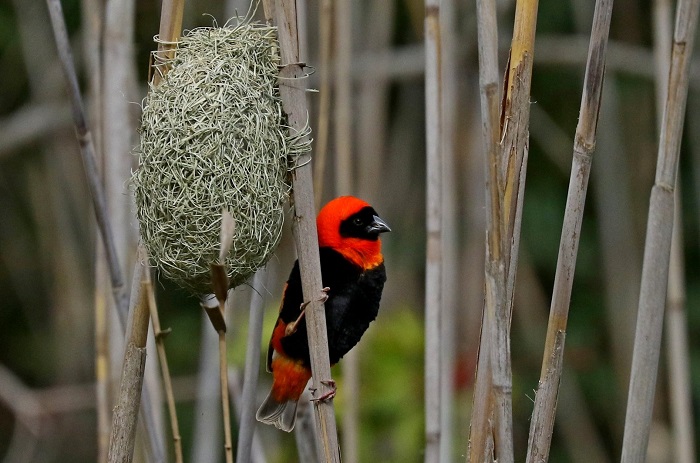
Settlers Park, Gqeberha, Eastern Cape
Photo by Jorrie Jordaan
1 to 5 eggs are laid per clutch, usually laid on successive days. The eggs are usually plain, pale bluish green to turquoise in colour. Incubation generally starts before clutch completion and lasts for around 12 days. Incubation is performed solely by the female. The newly hatched young are fed by the female only, on regurgitated insects and seeds. The nestlings are ready to leave the nest about 15 days later. Southern Red Bishops are sometimes double brooded particularly if the first clutch fails. Predation is the main cause of breeding failure in the Southern Red Bishop. Known nest predators for this species include Rats, Monitor lizards, snakes, various Mongoose species and other birds such as the Burchell’s Coucal (Centropus burchelli).

Albert Falls Nature Reserve, KwaZulu-Natal
Photo by Malcolm Robinson
Southern Red Bishop broods are regularly parasitised by the Diderick Cuckoo (Chrysococcyx caprius). However, male bishops regularly attack Cuckoos near breeding colonies. Their defensive efforts are quite successful as high rates of parasitism are found only at small colonies.
Further Resources
Species text adapted from the first Southern African Bird Atlas Project (SABAP1), 1997.
The use of photographs by Dave Rimmer, Derek Kennedy, Johan and Estelle van Rooyen, Jorrie Jordaan, Lia Steen, Malcolm Robinson, Pieter Cronje, Rowan Poortier and Tony Archer is acknowledged.
Virtual Museum (BirdPix > Search VM > By Scientific or Common Name).
Other common names: Rooivink (Afrikaans); iBomvana (Zulu); Intakomlilo (Xhosa); Thaga (Tswana); Oryxweber (German); Euplecte ignicolore (French); Grenadierwever (Dutch); Cardeal-tecelão-vermelho (Portuguese).
Recommended citation format: Tippett RM 2023. Southern Red Bishop Euplectes orix. Biodiversity and Development Institute. Available online at http://thebdi.org/2023/03/20/orange-river-white-eye-zosterops-pallidus/
List of bird species in this format is available here.
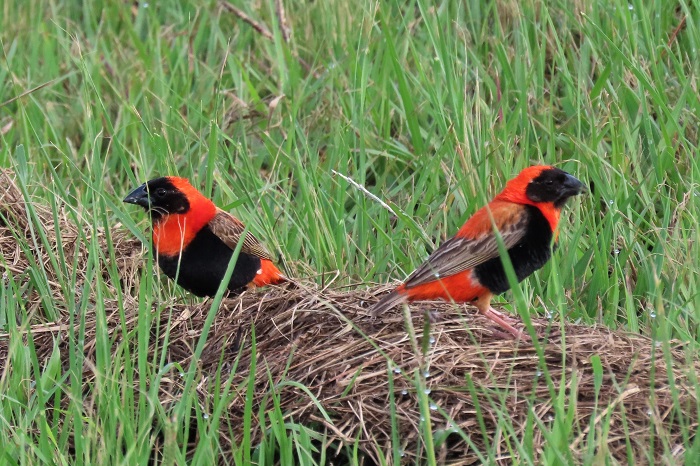
Albert Falls Nature Reserve, KwaZulu-Natal
Photo by Malcolm Robinson

